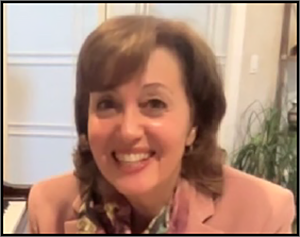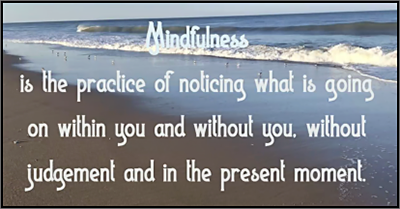Music Educators Association of New Jersey
Serving teachers and students since 1927



If you have spoken in person to the new MEA president Danette Whelan or watched her on one of her Zoom meetings, you’ve undoubtedly noticed she has a calm demeanor. Always smiling and pleasant, she radiates calm, confidence and a presence that says she is comfortable in her own skin.
 Danette wasn’t always that way. Her path to mindfulness emanated from earlier experiences with anxiety and the side effects of chronic lyme disease. When Western medicine did not help, she turned to meditation, experiencing nature, walking on the beach, enjoying students who were enthusiastic about playing. But this was not as easy a fix as it might appear. First, she needed to release past traumas and replace them with selfcare, gratitude and forgiveness. She could not free herself of past events and the feelings that accompanied them. She saw herself as a victim; and even imagining the future brought negative thoughts. With practice, she was able to overcome the negative feelings and completely reverse the anxiety, depression and fatigue—and became the joyful, clear-thinking person she is today. In fact, she went so deeply into meditation and mindfulness that she became a MNDFL Certified Mindfulness and Meditation Instructor. She practices this in her piano studio.
Danette wasn’t always that way. Her path to mindfulness emanated from earlier experiences with anxiety and the side effects of chronic lyme disease. When Western medicine did not help, she turned to meditation, experiencing nature, walking on the beach, enjoying students who were enthusiastic about playing. But this was not as easy a fix as it might appear. First, she needed to release past traumas and replace them with selfcare, gratitude and forgiveness. She could not free herself of past events and the feelings that accompanied them. She saw herself as a victim; and even imagining the future brought negative thoughts. With practice, she was able to overcome the negative feelings and completely reverse the anxiety, depression and fatigue—and became the joyful, clear-thinking person she is today. In fact, she went so deeply into meditation and mindfulness that she became a MNDFL Certified Mindfulness and Meditation Instructor. She practices this in her piano studio.
Meditation. Danette started with meditation and the breathing exercises that help to relax. In this Zoom presentation, she invited the audience to participate: sit so you are physically comfortable with your feet on the floor (or ground); focus on parts of your body—the jaw, neck, shoulders, hands, belly, lower back. Breathe slowly three times, use your breath to return to the present moment. Breathe without judgment of yourself. It may take a while to “get this.” This is what leads to Mindfulness.
Benefits of Mindfulness.
 It relieves stress and anxiety. Laura Amoriello, a co-presenter and a MNDFL and Open Heart Certified Meditation Instructor, started doing meditation 11 years ago and was amazed at how many negative thoughts she had had. As she practiced breathing/meditation, especially in 2020 while she coped with COVID and having her three-year-old daughter stay at home, she found that her stress level went down and she was able to sleep better. She explained the further benefits of mindfulness:
It relieves stress and anxiety. Laura Amoriello, a co-presenter and a MNDFL and Open Heart Certified Meditation Instructor, started doing meditation 11 years ago and was amazed at how many negative thoughts she had had. As she practiced breathing/meditation, especially in 2020 while she coped with COVID and having her three-year-old daughter stay at home, she found that her stress level went down and she was able to sleep better. She explained the further benefits of mindfulness: It improves focus and concentration. When practicing the piano, for example, you can use the music as an anchor. The musical “distractions” can be used to focus your full attention.
It improves focus and concentration. When practicing the piano, for example, you can use the music as an anchor. The musical “distractions” can be used to focus your full attention.
Teaching with Mindfulness.
 Fernanda was overwhelmed during the COVID experience because she had three energetic children at home. Turning to breathing and mindfulness made a huge difference in her life and her teaching. The role of the brain, she learned, was most fascinating because it helps us activate the panic button. It prepares us to deal with stress. How does the body react? We hyperventilate, lack concentration, get sick and make poor decisions. The parasympathetic nervous system is in charge of the “rest and digest” parts of the body. “So when all else fails, breathe!” It will help your whole body, calm your mind, and reach all the organs of the parasympathetic nervous system.
Fernanda was overwhelmed during the COVID experience because she had three energetic children at home. Turning to breathing and mindfulness made a huge difference in her life and her teaching. The role of the brain, she learned, was most fascinating because it helps us activate the panic button. It prepares us to deal with stress. How does the body react? We hyperventilate, lack concentration, get sick and make poor decisions. The parasympathetic nervous system is in charge of the “rest and digest” parts of the body. “So when all else fails, breathe!” It will help your whole body, calm your mind, and reach all the organs of the parasympathetic nervous system.
In the studio, Danette uses improvisation as another mindfulness technique every student can do. All about exploring, there are no mistakes, no judgments, no limitations. It’s a great confidence builder — and most kids find it’s fun too!
Danette also discovered in discussions with her students that they all preferred the title “Sharing Music Program” rather than “Recital.” The word “recital” created anxiety. She talks about anxiety at her recitals so her students can relax and be mindful and switch from “anxious” to “excited.” They can then work with the Growth Mindset.

To further emphasize the positivity, Danette ends her Sharing Music Programs with these love and kindness wishes:
May you be happy * May you be healthy * May you be safe *
May you live without pain and suffering *
May you live with peace. . . .
Charlene Step
Writer and Page Designer
Laura Amoriello is a MNDFL Certified Meditation Instructor and an Associate Teacher of the Art of Practicing Institute, where she works closely with Madeline Bruser. She is a member of the Wellness Committee for the National Conference on Keyboard Pedagogy. Laura holds a Dr. of Education degree from Columbia University, a Master’s from Penn State and a Bachelor’s from Westminster Choir College. After 18 years teaching college, she is currently on the faculty of the Opus Ithaca School of Music. She also teaches privately, employing mindfulness practices and a holistic approach emphasizing the mind-body connection.
Fernanda Nieto was born and studied in Argentina before she received her Masters in Piano Performance/ Pedagogy at Ohio University and her Doctorate in Piano Performance at the U. of Colorado (Boulder). In her career as a collaborator, performer and clinician, she has worked with composers, conductors, soloists and choruses in Colorado, Ohio, Wisconsin and California. She enjoys teaching students of all ages and uses mindfulness techniques in her studio.
For more information on mindfulness, please see the websites for Laura Amoriello, Fernanda Nieto Piano, Performing Beyond Fear, and The Art of Practicing by Madeline Bruner.